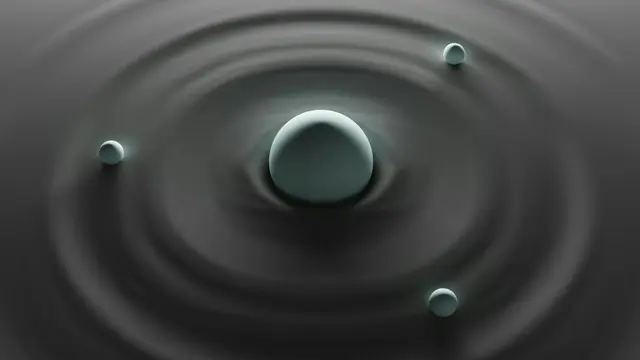The scientific community is abuzz with a new theory that challenges the long-held belief in dark matter as a critical component in galaxy formation and gravitational interactions.
The research, conducted by Dr. Richard Lieu from the University of Alabama in Huntsville, posits that topological defects, rather than dark matter, could be the source of the gravitational bending observed in galaxies.

To understand this disruptive idea, we need to revisit the basics of our understanding of galaxies.
According to the theory of general relativity, the visible mass in many galaxies isn’t sufficient to account for the gravitational forces holding them together.
This gap led to the hypothesis of dark matter — a mysterious and invisible mass that doesn’t interact with light but exerts a significant gravitational pull.
For nearly a century, scientists have attributed the unseen gravitational influences in the universe to dark matter.
However, a century’s worth of investigations hasn’t produced direct proof of its existence.
Driven by this lack of evidence, Dr. Lieu embarked on a journey to explore alternative explanations.
This study introduces the concept of topological defects, which are unique structures in space that emerge from phase transitions in the early universe.
These defects can appear in different forms, such as cosmic strings or shell-like formations, characterized by a distinctive arrangement of positive and negative mass.
Interestingly, the idea here is not to measure the mass as we traditionally understand it.
According to Lieu, these shell-like formations have zero total mass yet exert significant gravitational forces.
When light or stars pass through these shells, significant inward gravitational effects are observed, leading to notable gravitational bending.
Gravitational bending, or the deflection of light around massive objects, has long been considered indirect evidence for dark matter’s presence.
However, Lieu’s research suggests that the observed bending could be a result of these massless topological defects rather than the elusive dark matter.
Despite this groundbreaking approach, Lieu is cautious.
He acknowledges that his theory isn’t yet sufficient to completely discredit the dark matter hypothesis but emphasizes it’s the first concrete evidence showing that gravity might exist independently of mass.
The challenge now lies in further research to understand how these topological defects align to form galaxies or clusters and how they evolve over time.
Questions linger about the initial formation of these defects and how they might be detected through observation.
While the idea might still be in its infancy, it opens exciting avenues for exploring the universe beyond dark matter hypotheses.
Future work will delve deeper into confirming or refuting these structures, providing new insights into cosmic evolution and the fundamental forces at play in the cosmos.
The results of Dr. Lieu’s study offer a fresh perspective, reminding us that the universe holds more mysteries than we may comprehend, and that sometimes, solutions lie in looking beyond established paradigms.
The scientific community is abuzz with a new theory that challenges the long-held belief in dark matter as a critical component in galaxy formation and gravitational interactions.
The research, conducted by Dr. Richard Lieu from the University of Alabama in Huntsville, posits that topological defects, rather than dark matter, could be the source of the gravitational bending observed in galaxies.
To understand this disruptive idea, we need to revisit the basics of our understanding of galaxies.
According to the theory of general relativity, the visible mass in many galaxies isn’t sufficient to account for the gravitational forces holding them together.
This gap led to the hypothesis of dark matter — a mysterious and invisible mass that doesn’t interact with light but exerts a significant gravitational pull.
For nearly a century, scientists have attributed the unseen gravitational influences in the universe to dark matter.
However, a century’s worth of investigations hasn’t produced direct proof of its existence.
Driven by this lack of evidence, Dr. Lieu embarked on a journey to explore alternative explanations.
This study introduces the concept of topological defects, which are unique structures in space that emerge from phase transitions in the early universe.
These defects can appear in different forms, such as cosmic strings or shell-like formations, characterized by a distinctive arrangement of positive and negative mass.
Interestingly, the idea here is not to measure the mass as we traditionally understand it.
According to Lieu, these shell-like formations have zero total mass yet exert significant gravitational forces.
When light or stars pass through these shells, significant inward gravitational effects are observed, leading to notable gravitational bending.
Gravitational bending, or the deflection of light around massive objects, has long been considered indirect evidence for dark matter’s presence.
However, Lieu’s research suggests that the observed bending could be a result of these massless topological defects rather than the elusive dark matter.
Despite this groundbreaking approach, Lieu is cautious.
He acknowledges that his theory isn’t yet sufficient to completely discredit the dark matter hypothesis but emphasizes it’s the first concrete evidence showing that gravity might exist independently of mass.
The challenge now lies in further research to understand how these topological defects align to form galaxies or clusters and how they evolve over time.
Questions linger about the initial formation of these defects and how they might be detected through observation.
While the idea might still be in its infancy, it opens exciting avenues for exploring the universe beyond dark matter hypotheses.
Future work will delve deeper into confirming or refuting these structures, providing new insights into cosmic evolution and the fundamental forces at play in the cosmos.
The results of Dr. Lieu’s study offer a fresh perspective, reminding us that the universe holds more mysteries than we may comprehend, and that sometimes, solutions lie in looking beyond established paradigms.
